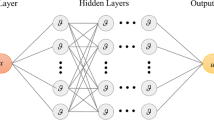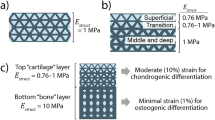Abstract
Quantitative computed tomography (QCT)-based finite element (FE) models of the vertebra are widely used in studying spine biomechanics and mechanobiology, but their accuracy has not been fully established. Although the models typically assign material properties based only on local bone mineral density (BMD), the mechanical behavior of trabecular bone also depends on fabric. The goal of this study was to determine the effect of incorporating measurements of fabric on the accuracy of FE predictions of vertebral deformation. Accuracy was assessed by using displacement fields measured via digital volume correlation—applied to time-lapse microcomputed tomography (μCT)—as the gold standard. Two QCT-based FE models were generated from human L1 vertebrae (n = 11): the entire vertebral body and a cuboid-shaped portion of the trabecular centrum [dimensions: (20–30) × (15–20) × (15–20) mm3]. For axial compression boundary conditions, there was no difference (p = 0.40) in the accuracy of the FE-computed displacements for models using material properties based on local values of BMD versus those using material properties based on local values of fabric and volume fraction. However, when using BMD-based material properties, errors were higher for the vertebral-body models (8.4–50.1%) than cuboid models (1.5–19.6%), suggesting that these properties are inaccurate in the peripheral regions of the centrum. Errors also increased when assuming that the cuboid region experienced uniaxial loading during axial compression of the vertebra. These findings indicate that a BMD-based constitutive model is not sufficient for the peripheral region of the vertebral body when seeking accurate QCT-based FE modeling of the vertebra.







Similar content being viewed by others
References
Bevill G, Eswaran SK, Farahmand F, Keaveny TM (2009a) The influence of boundary conditions and loading mode on high-resolution finite element-computed trabecular tissue properties. Bone 44:573–578. https://doi.org/10.1016/j.bone.2008.11.015
Bevill G, Farhamand F, Keaveny TM (2009b) Heterogeneity of yield strain in low-density versus high-density human trabecular bone. J Biomech 42:2165–2170. https://doi.org/10.1016/j.jbiomech.2009.05.023
Buckley JM, Cheng L, Loo K et al (2007) Quantitative computed tomography-based predictions of vertebral strength in anterior bending. Spine (Phila Pa 1976) 32:1019–1027. https://doi.org/10.1097/01.brs.0000260979.98101.9c
Chevalier Y, Charlebois M, Pahr D et al (2008) A patient-specific finite element methodology to predict damage accumulation in vertebral bodies under axial compression, sagittal flexion and combined loads. Comput Methods Biomech Biomed Eng 11:477–487. https://doi.org/10.1080/10255840802078022
Chevalier Y, Pahr D, Zysset PK (2009) The role of cortical shell and trabecular fabric in finite element analysis of the human vertebral body. J Biomech Eng 131:111003. https://doi.org/10.1115/1.3212097
Costa MC, Tozzi G, Cristofolini L et al (2017) Micro finite element models of the vertebral body: validation of local displacement predictions. PLoS ONE 12:1–18. https://doi.org/10.1371/journal.pone.0180151
Cowin SC (1985) The relationship between the elasticity tensor and the fabric tensor. Mech Mater 4:137–147
Cowin SC (2004) Tissue growth and remodeling. Annu Rev Biomed Eng 6:77–107
Cowin SC, Hegedus DH (1976) Bone remodeling I: theory of adaptive elasticity. J Elast 6:313–326
Cowin S, Yang G (1997) Averaging anisotropic elastic constant data. J Elast 46:151–180
Crawford RP, Cann CE, Keaveny TM (2003a) Finite element models predict in vitro vertebral body compressive strength better than quantitative computed tomography. Bone 33:744–750. https://doi.org/10.1016/S8756-3282(03)00210-2
Crawford RP, Rosenberg WS, Keaveny TM (2003b) Quantitative tomography-based finite element models of the human lumbar vertebral body: effect of element size on stiffness, damage, and fracture strength. J Biomech Eng 125:434–438. https://doi.org/10.1115/1.1589772
Dall’Ara E, Schmidt R, Pahr D et al (2010) A nonlinear finite element model validation study based on a novel experimental technique for inducing anterior wedge-shape fractures in human vertebral bodies in vitro. J Biomech 43:2374–2380. https://doi.org/10.1016/j.jbiomech.2010.04.023
Dall’Ara E, Pahr D, Varga P et al (2012) QCT-based finite element models predict human vertebral strength in vitro significantly better than simulated DEXA. Osteoporos Int 23:563–572. https://doi.org/10.1007/s00198-011-1568-3
Eckstein F, Fischbeck M, Kuhn V et al (2004) Determinants and heterogeneity of mechanical competence throughout the thoracolumbar spine of elderly women and men. Bone 35:364–374. https://doi.org/10.1016/j.bone.2004.04.008
Fields AJ, Lee GL, Liu XS et al (2011) Influence of vertical trabeculae on the compressive strength of the human vertebra. J Bone Miner Res 26:263–269
Hazrati Marangalou J, Ito K, van Rietbergen B (2012) A new approach to determine the accuracy of morphology-elasticity relationships in continuum FE analyses of human proximal femur. J Biomech 45:2884–2892. https://doi.org/10.1016/j.jbiomech.2012.08.022
Hoffler CE, Moore KE, Kozloff K et al (2000) Heterogeneity of bone lamellar-level elastic moduli. Bone 26:603–609
Homminga J, Van-Rietbergen B, Lochmuller EM et al (2004) The osteoporotic vertebral structure is well adapted to the loads of daily life, but not to infrequent “error” loads. Bone 34:510–516. https://doi.org/10.1016/j.bone.2003.12.001
Hosseini HS, Clouthier AL, Zysset PK (2014) Experimental validation of finite element analysis of human vertebral collapse under large compressive strains. J Biomech Eng. https://doi.org/10.1115/1.4026409
Hussein AI, Barbone PE, Morgan EF (2012) Digital volume correlation for study of the mechanics of whole bones. Procedia IUTAM 4:116–125. https://doi.org/10.1016/j.piutam.2012.05.013
Hussein AI, Mason ZD, Morgan EF (2013) Presence of intervertebral discs alters observed stiffness and failure mechanisms in the vertebra. J Biomech 46:1683–1688. https://doi.org/10.1016/j.jbiomech.2013.04.004
Hussein AI, Louzeiro DT, Unnikrishnan GU, Morgan EF (2018) Differences in trabecular microarchitecture and simplified boundary conditions limit the accuracy of quantitative computed tomography-based finite element models of vertebral failure. J Biomech Eng. https://doi.org/10.1115/1.4038609
Jackman TM, Hussein AI, Adams AM et al (2014) Endplate deflection is a defining feature of vertebral fracture and is associated with properties of the underlying trabecular bone. J Orthop Res. https://doi.org/10.1002/jor.22620
Jackman TM, DelMonaco AM, Morgan EF (2016) Accuracy of finite element analyses of CT scans in predictions of vertebral failure patterns under axial compression and anterior flexion. J Biomech 49:267–275. https://doi.org/10.1016/j.jbiomech.2015.12.004
Kabel J, van Rietbergen B, Odgaard A, Huiskes R (1999) Constitutive relationships of fabric, density, and elastic properties in cancellous bone architecture. Bone 25:481–486
Kanis JA, Johnell O, Oden A et al (2002) Ten-year risk of osteoporotic fracture and the effect of risk factors on screening strategies. Bone 30:251–258
Keaveny TM, Morgan EF, Niebur GL, Yeh OC (2001) Biomechanics of trabecular bone. Annu Rev Biomed Eng 3:307–333
Kopperdahl DL, Morgan EF, Keaveny TM (2002) Quantitative computed tomography estimates of the mechanical properties of human vertebral trabecular bone. J Orthop Res 20:801–805. https://doi.org/10.1016/S0736-0266(01)00185-1
Larsson D, Luisier B, Kersh ME et al (2014) Assessment of transverse isotropy in clinical-level CT images of trabecular bone using the gradient structure tensor. Ann Biomed Eng 42:950–959. https://doi.org/10.1007/s10439-014-0983-y
Lempriere BM (1968) Poisson’s ratio in orthotropic materials. AIAA J 6:2226–2227
Liebschner MAK, Kopperdahl DL, Rosenberg WS, Keaveny TM (2003) Finite element modeling of the human thoracolumbar spine. Spine (Phila Pa 1976) 28:559. https://doi.org/10.1097/01.brs.0000049923.27694.47
Lochmüller E-M, Pöschl K, Würstlin L et al (2008) Does thoracic or lumbar spine bone architecture predict vertebral failure strength more accurately than density? With other metabolic bone disease. Osteoporos Int 19:537–545. https://doi.org/10.1007/s00198-007-0478-x
Luisier B, Ara ED, Pahr DH (2014) Orthotropic HR-pQCT-based FE models improve strength predictions for stance but not for side-way fall loading compared to isotropic QCT-based FE models of human femurs. J Mech Behav Biomed Mater 32:287–299. https://doi.org/10.1016/j.jmbbm.2014.01.006
Lyritis GP, Mayasis B, Tsakalakos N et al (1989) The natural history of the osteoporotic vertebral fracture. Clin Rheumatol 8(Suppl 2):66–69
Pahr DH, Zysset PK (2009) A comparison of enhanced continuum FE with micro FE models of human vertebral bodies. J Biomech 42:455–462
Pahr DH, Schwiedrzik J, Dall’Ara E, Zysset PK (2014) Clinical versus pre-clinical FE models for vertebral body strength predictions. J Mech Behav Biomed Mater 33:76–83. https://doi.org/10.1016/j.jmbbm.2012.11.018
Panyasantisuk J, Pahr DH, Gross T, Zysset PK (2015) Comparison of mixed and kinematic uniform boundary conditions in homogenized elasticity of femoral trabecular bone using microfinite element analyses. J Biomech Eng. https://doi.org/10.1115/1.4028968
Riggs BL, Melton LJ (1995) The worldwide problem of osteoporosis: insights afforded by epidemiology. Bone 17:S505–S511. https://doi.org/10.1016/8756-3282(95)00258-4
Rincón-Kohli L, Zysset PK (2009) Multi-axial mechanical properties of human trabecular bone. Biomech Model Mechanobiol 8:195–208. https://doi.org/10.1007/s10237-008-0128-z
Silva MJ, Wang C, Keaveny TM, Hayes WC (1994) Direct and computed tomography thickness measurements of the human, lumbar vertebral shell and endplate. Bone 15:409–414
Ulrich D, van Rietbergen B, Laib A, Rüegsegger P (1999) The ability of three-dimensional structural indices to reflect mechanical aspects of trabecular bone. Bone 25:55–60
Unnikrishnan GU, Barest GD, Berry DB et al (2013) Effect of specimen-specific anisotropic material properties in quantitative computed tomography-based finite element analysis of the vertebra. J Biomech Eng 135:101007–101011. https://doi.org/10.1115/1.4025179
Wolfram U, Schmitz B, Heuer F et al (2009) Vertebral trabecular main direction can be determined from clinical CT datasets using the gradient structure tensor and not the inertia tensor—a case study. J Biomech 42:1390–1396. https://doi.org/10.1016/j.jbiomech.2009.04.006
Zysset PK, Curnier A (1995) An alternative model for anisotropic elasticity based on fabric tensors. Mech Mater 21:243–250
Acknowledgements
Funding was provided by the National Institutes of Health Grant AR054620 and the National Science Foundation Grant BES-9625030.
Author information
Authors and Affiliations
Corresponding author
Ethics declarations
Conflict of interest
The authors declare that they have no conflicts of interest.
Additional information
Publisher's Note
Springer Nature remains neutral with regard to jurisdictional claims in published maps and institutional affiliations.
Electronic supplementary material
Below is the link to the electronic supplementary material.
Rights and permissions
About this article
Cite this article
Wu, Y., Morgan, E.F. Effect of fabric on the accuracy of computed tomography-based finite element analyses of the vertebra. Biomech Model Mechanobiol 19, 505–517 (2020). https://doi.org/10.1007/s10237-019-01225-2
Received:
Accepted:
Published:
Issue Date:
DOI: https://doi.org/10.1007/s10237-019-01225-2




